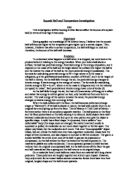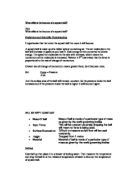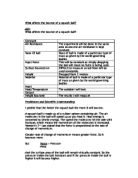Abhirath Singh
0434
Bouncing A Squash Ball Lab Report
Aim: To investigate the effect of temperature on the bouncing capacity of a squash ball.
Hypothesis: The bouncing capacity of the ball and its temperature are directly proportional. This means that as the temperature increases, so does the bouncing capacity of the ball.
Background: A squash ball is an elastic solid, which returns to its original shape, after being acted on by a force. Therefore, it is hard to bounce a squash ball, as on collision, the ball loses its shape, as the air inside it allows the ball to lose its shape. In this experiment, we will attempt to find to find the effect of temperature on the bouncing capacity of a ball.

This is a preview of the whole essay
Peer Reviews
Here's what a star student thought of this essay
Quality of writing
Having done this experiment myself, I would say ‘first rebound height’ instead of ‘bouncing capacity’. ‘Bouncing capacity’ is quite ambiguous as it does not inform us about what was actually measured. Linked to this, some language is a little imprecise – in the results table, ‘try’ should ‘trial’. This is standard in most scientific reports and sounds more professional than ‘try’. Overall, the report is very well written with good analysis. If the above suggestions were put in place, this could well be a 4* piece.
Level of analysis
The level of analysis is very good – as mentioned above, results are presented well showing the trend clearly. Analysis of errors is good, but could be improved as above. One error that should be noted however is that the hot water would inevitably change the temperature of the rubber. This means that you are changing the temperature of air inside (the primary factor that you consider your independent variable) but also the temperature of the rubber itself, which would have an inevitable effect on the bouncing capacity. This is a fundamental flaw in the procedure that should be addressed in the report. Furthermore, it is very difficult to determine the actual rebound height with the naked eye – you would be better off using a video then analysing frame by frame. This would lead to a much more accurate result.
Response to question
The response to question is good – the lab report fulfils its purpose of informing the reader of the procedure and the results obtained. For this review I will diverge slightly from the standard structure – a lab report doesn’t lend itself to the question criteria used for most reviews. Overall it is a very good lab report – results are presented clearly, something important for lab reports. One thing that you should put in is how the errors affected results. Tell us what the ball not being completely submerged would do to the overall bouncing capacity. This is a very valuable aspect to do as it shows you understand the procedure and its errors.







